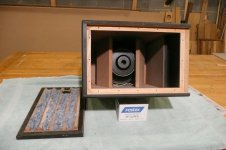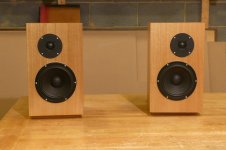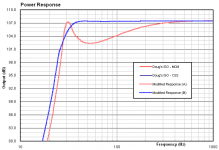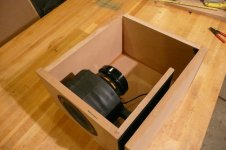Hi,
Who said I didn't like isobarics ? They are great for the right drivers,
and the right circumstances, they typically allow drivers to be used
for a case when the box for one driver is too big, you can halve it.
And a poor / pointless choice for the wrong driver, you keep saying
they are great going by ..... whatever. I have said the 30Hz vented
isobaric version has a box that is far too big with a big peak at 30Hz,
that the two drivers used normally in the same box will sound better,
go just as deep but avoid the peak, and go 6dB louder, effectively
quadrupling the apparent amplifier power over the isobaric as they
will also be 6dB more efficient.
Literally twice as good, its like having two of the isobarics.
Your right of not a fan of this "design" because it isn't one IMO,
it models very poorly, suggesting wrong design decisions, a more
thought out proper design has overwhelming advantages, done right.
You seem to be saying you can't see what's wrong with it .....
Do some modelling and you will soon see, isobaric with this driver
costs an extra driver and a beefier amplifier for no real purpose,
and you end up with silly small box sizes for the best performance.
rgds, sreten.
It is a little frustrating we are going round and round, and one of us won't grasp the brass ring.
The modeling - that's not going to be much of a shock.
The part I don't understand is: if the box is way too big - why is the tuning dead on? Perfect Balance.
btw, the combination is hardly a power hungry glutton, just the opposite.
It is a little frustrating we are going round and round, and one of us won't grasp the brass ring.
The modeling - that's not going to be much of a shock.
The part I don't understand is: if the box is way too big - why is the tuning dead on? Perfect Balance.
btw, the combination is hardly a power hungry glutton, just the opposite.
Hi,
You say the tuning is dead on, but it isn't. It may interact fortuitously
will your room, but then your just lucky, not something to recommend.
Its like the UnABL farce, people insisting stuff that is simply not true.
With the same drivers, the same box volume, same amplifier and same
vent tuning you can build one box that betters two of the isobaric subs,
i,e, one box, two drivers and one amp will outperform two boxes, 4
drivers and two amplifiers, its a utter no-brainer, build it properly,
or a least stop implying its a good way to use this driver, it isn't.
Literally get more than twice as much for your effort, in a package
that may have twice the WAF of the equivalent isobaric approach.
Why are you ignoring the modelling, its accurate and you have
accurate parameters ? You've got NIHS in a very bad way IMHO.
I'm getting very bored, your too lazy to do the modelling yourself,
and all you can come up with is a very poor implication its pointless.
rgds, sreten.
Last edited:
Tuning: I was referring to the peaks and valley during the tuning (port size), Post 52. As far as I know there's no way that would look as good as it does, with the wrong size box.
There is nothing to prove or gain here, I am just passing on countless hours of R&D work, done over many years.
I know the speaker does not look good in modeling programs, I knew that 10 years ago. This was also mentioned from the seller, at the same point in time.
Around and around............Please, if you are bored with all this, it's okay if you move on. You're input has been considered.
Thank you.
There is nothing to prove or gain here, I am just passing on countless hours of R&D work, done over many years.
I know the speaker does not look good in modeling programs, I knew that 10 years ago. This was also mentioned from the seller, at the same point in time.
Around and around............Please, if you are bored with all this, it's okay if you move on. You're input has been considered.
Thank you.
All Right Michael!!
These 8" inexpensive woofers have brought me years of enjoyable music/bass. They work much better than the low price tag suggest.
I've rolled many a sub-woofer-speaker though here, I keep coming back to these.
May just work with 2 units in a 18L Bandpass. F3 approx 40Hz - 120 Hz (Black Plot below).
These 8" inexpensive woofers have brought me years of enjoyable music/bass. They work much better than the low price tag suggest.
I've rolled many a sub-woofer-speaker though here, I keep coming back to these.
There is nothing to prove or gain here, I am just passing on countless hours of R&D work, done over many years.
I know the speaker does not look good in modeling programs, I knew that 10 years ago. This was also mentioned from the seller, at the same point in time.
Around and around............Please, if you are bored with all this, it's okay if you move on. You're input has been considered.
Thank you.
Hi, Yeah, I was right, stick your head in the sand, just stop giving poor clueless advice, rgds, sreten.
No ducking here Simon ~ I am not the one with the limited imagination.
Hi,
Too right, you have too much imagination, Simon ? and have no willing to learn,
You've taken garbage information on board and made it worse, but its right ....
It isn't....
rgds, sreten.
Fact is, playing with real reliable facts in physics, is a lot more fun, seems to be lost on you.
Having a model of what you are going to get is great, what on earth is wrong with that ?
All you need to extensively play with WinISD is Fs - 26Hz, Qts - 0.19 and Vas - 35L.
also see : http://www.diyaudio.com/forums/subwoofers/192075-mcm-8-55-2421-ts-parameter.html
Last edited:
There are two baffle plates ~ to break up standing waves.
What standing waves? That cabinet is far too small to have standing waves at the frequencies it's being used for. The angled partitions may help brace the walls, but that's all.
I stand corrected. They probably do more bracing than anything.
However I have seen small angle "boards" in book shelf speakers. Sometimes I'll clamps a 45 degree board, right next to the woofer (between the W and T) on the front baffle plate. A ploy I copied from a fellow that was heavy into attenuating standing/back waves. He also used foam blocks, cut with sharp pointed pyramids.
Hey folks, I sold one sub to a friend (for peanuts btw), he'll be using it this weekend, I'll post comments...good or bad. He'll be using Zaph SR71s that I build him a few weeks ago.
However I have seen small angle "boards" in book shelf speakers. Sometimes I'll clamps a 45 degree board, right next to the woofer (between the W and T) on the front baffle plate. A ploy I copied from a fellow that was heavy into attenuating standing/back waves. He also used foam blocks, cut with sharp pointed pyramids.
Hey folks, I sold one sub to a friend (for peanuts btw), he'll be using it this weekend, I'll post comments...good or bad. He'll be using Zaph SR71s that I build him a few weeks ago.
Attachments
Last edited:
Hi,
FWIW wedge shapes are a lot easier to cut and far less wasteful than pyramids
as they have no waste, and pyramids have lots. Usually deployed in a grid with
the wedge axis on each one alternating with position, as in anechoic chambers :
rgds, sreten.
FWIW wedge shapes are a lot easier to cut and far less wasteful than pyramids
as they have no waste, and pyramids have lots. Usually deployed in a grid with
the wedge axis on each one alternating with position, as in anechoic chambers :
An externally hosted image should be here but it was not working when we last tested it.
rgds, sreten.
Good Pic. The fellow used to cut a pyramid grid (similar to what you have shown); I would agree that, about half the material was wasted.
I never could figure out how he cut the grid, table saw, band saw, long bread knife; maybe he just bought it?
I never could figure out how he cut the grid, table saw, band saw, long bread knife; maybe he just bought it?
I stand corrected. They probably do more bracing than anything.
However I have seen small angle "boards" in book shelf speakers. ...
They would be more useful there, where the woofer does mid duties as well.
Looking at your design, the biggest problem I see, apart from the ones that other people have already pointed out, is that your slot port is too small and has very high losses. You can see that from the relative size of the 20Hz and 40Hz resonant peaks. If your port was more efficient, the speaker would have a lower excursion for the same output at resonance. The port ought to be 2 to 3 times as large (cross section) as it is now, and of course a lot longer if you want to keep the 30 Hz tuning point. It then gets hard to fit a port that long into the enclosure. Do consider it though, because the results are desirable - lower distortion because the drivers don't exceed xmax at high power, and less port noise ("chuffing").
I wouldn't build these enclosures for myself. They are simply too large and tuned too low for the drivers to give of their best. Your description of their performance (in post #73) shows that. The problem is, there doesn't appear to be any way the drivers are suitable for sub-bass use. They would make a good woofer, or maybe in a bandpass enclosure as suggested by Michael.
I note that a single CSS Trio8 would be a better match to your enclosure, and would provide about the same output for the same power and a similar price (1 Trio8 vs 2 55-2421, assuming both at full retail price.)
Don,
Your constructive thoughts are appreciated. I have been giving these speakers some thought in a different light and also when back and compared them to some other sub woofers.
Okay, port noise, yes there is some, I noticed it the other day when checking the tuning, it can not be heard in any music, movie, etc.
I realize now why all the controversy, the design was not done on paper first; it was all done in the shop. There not much to go on but my descriptions, but I have been making subwoofers for a long time, HT, 2.1, ported, sealed, band pass, etc.
I don’t know what to tell you all, they sound great, pound away, I think by now everyone realizes that there is quite a bump in the 30hz range and the part I like.
However there is not a huge drop above that and are reasonably smooth using a sweeping generator test. (how smooth can a $30 woofer be anyway?)
#1 reason I like these ~ can hear them at a very low level, there are 9 other reasons, but I think we covered that ~ maybe not #11, fun to build.
Btw, I do use speaker design programs and have two.
Your constructive thoughts are appreciated. I have been giving these speakers some thought in a different light and also when back and compared them to some other sub woofers.
Okay, port noise, yes there is some, I noticed it the other day when checking the tuning, it can not be heard in any music, movie, etc.
I realize now why all the controversy, the design was not done on paper first; it was all done in the shop. There not much to go on but my descriptions, but I have been making subwoofers for a long time, HT, 2.1, ported, sealed, band pass, etc.
I don’t know what to tell you all, they sound great, pound away, I think by now everyone realizes that there is quite a bump in the 30hz range and the part I like.
However there is not a huge drop above that and are reasonably smooth using a sweeping generator test. (how smooth can a $30 woofer be anyway?)
#1 reason I like these ~ can hear them at a very low level, there are 9 other reasons, but I think we covered that ~ maybe not #11, fun to build.
Btw, I do use speaker design programs and have two.
1 Trio8 vs 2 55-2421
Well that doesn't seem fair to me, but I'm a curious kind of guy. Is that a Mark Audio product? I bet his stuff is good.
How can I find a deal on one? All in the interest of science of course.
Be warned the 17” x 19” x 11-1/2” Iso boxes can slam the house!
*Port size, the Iso box port is over 100 square inches.
Oh btw, 1st report from my buddy that hooked one up this past weekend.
"Outstanding to say the least!!!!"
Well that doesn't seem fair to me, but I'm a curious kind of guy. Is that a Mark Audio product? I bet his stuff is good.
How can I find a deal on one? All in the interest of science of course.
Be warned the 17” x 19” x 11-1/2” Iso boxes can slam the house!
*Port size, the Iso box port is over 100 square inches.
Oh btw, 1st report from my buddy that hooked one up this past weekend.
"Outstanding to say the least!!!!"
Last edited:
Hi,
Nobody is saying they don't work and fair enough you like them.
But on Paper :
The isobaric could be rearranged as a normal sub with +6dB efficiency
and output, which would convert the 30Hz region to extended shelf.
Bass extension is just as good, but will be better due to extra SPL.
Or alternatively put, one driver in a smaller box with a PR and
a less juicy amplifier will work just as well as the isobaric.
The audible result of your build is not the issue, whatever people
think of it, or report, it is the design details they are unaware of.
If you like a bump at 30Hz the more gradual peak of sub with a built
in optional bass boost could work well for movies, turn it off for music.
The fact is on paper in an hour you can go through dozens of arrangements
in WinISD and that exercise will lead you to conclude isobaric for this driver
is near pointless. MCM gave you very bad advice about the driver that you
ran with and then went isobaric. Try running with some good advice.
The fact is with these drivers you can make very good compact subs,
that vented or better still PR'd will go down to around 30Hz will a
room friendly response shape above that.
Bandpass boxes IMO, due the small volumes required, and the criticality
of getting the fine tuning right, and not trusting the sims, IMO would
have to be built and tuned via an empirical measurement process.
rgds, sreten.
Nobody is saying they don't work and fair enough you like them.
But on Paper :
The isobaric could be rearranged as a normal sub with +6dB efficiency
and output, which would convert the 30Hz region to extended shelf.
Bass extension is just as good, but will be better due to extra SPL.
Or alternatively put, one driver in a smaller box with a PR and
a less juicy amplifier will work just as well as the isobaric.
The audible result of your build is not the issue, whatever people
think of it, or report, it is the design details they are unaware of.
If you like a bump at 30Hz the more gradual peak of sub with a built
in optional bass boost could work well for movies, turn it off for music.
The fact is on paper in an hour you can go through dozens of arrangements
in WinISD and that exercise will lead you to conclude isobaric for this driver
is near pointless. MCM gave you very bad advice about the driver that you
ran with and then went isobaric. Try running with some good advice.
The fact is with these drivers you can make very good compact subs,
that vented or better still PR'd will go down to around 30Hz will a
room friendly response shape above that.
Bandpass boxes IMO, due the small volumes required, and the criticality
of getting the fine tuning right, and not trusting the sims, IMO would
have to be built and tuned via an empirical measurement process.
rgds, sreten.
Doug,
I'm an isobaric fan myself, which is why I read this thread, but after doing the sums I can see the logic behind Sreten's recommendation of a standard layout 2 driver setup.
Regarding port size, you said your port is 10 inches wide and about 3/4 inch high. No way is that 100 square inches. A square port (10 inches by 10 inches) would be 100 square inches...
Regarding the CSS driver versus 2x MCM, see the attached graph.
It shows isobaric MCM 55-2421 versus single CSS Trio8 in a 30 litre enclosure tuned to 30 Hz. The MCM drivers are fed a total of 240 watts, and the CSS driver is fed 200 watts. (Ignore the "modified response" caption, the spreadsheet I used allows applying filters and adjusting for measured room response etc.)
I'm an isobaric fan myself, which is why I read this thread, but after doing the sums I can see the logic behind Sreten's recommendation of a standard layout 2 driver setup.
Regarding port size, you said your port is 10 inches wide and about 3/4 inch high. No way is that 100 square inches. A square port (10 inches by 10 inches) would be 100 square inches...
Regarding the CSS driver versus 2x MCM, see the attached graph.
It shows isobaric MCM 55-2421 versus single CSS Trio8 in a 30 litre enclosure tuned to 30 Hz. The MCM drivers are fed a total of 240 watts, and the CSS driver is fed 200 watts. (Ignore the "modified response" caption, the spreadsheet I used allows applying filters and adjusting for measured room response etc.)
Attachments
Last edited:
I see where you get the 100 from now, but it's about 100 cubic inches, not square inches.
Port volume is not usually used when calculating resonant frequency, because the port area and length have to be used separately in the Helmholtz calculation:
Your picture reminds me that I must subtract the coupling chamber volume from the enclosure volume next time I do the calcs.
I have sometimes wondered what difference the volume between the drivers makes to the performance of an isobaric system, which is normally modeled as if the drivers were rigidly coupled together. So I've just modeled it in AkAbak, and the results surprised me. Although the SPL performance is about the same as the "perfect" model, It makes quite a big difference to the driver excursion. Using a 1 cu ft enclosure and your 5 inch deep, 7 inch diameter coupling chamber as an example, the outer driver has almost 25% greater excursion than the inner driver. So for maximum performance from an isobaric design, the volume between the drivers must be as small as possible. This implies mounting them face to face, but you then expose noisemakers which are normally hidden such as the tinsel leads, spiders and the air vent in the magnet (if present).
There is no free lunch...
Port volume is not usually used when calculating resonant frequency, because the port area and length have to be used separately in the Helmholtz calculation:
Code:
____________________________
Speed of Sound / Port Area
F Res = ---------------- X /------------------------------
2 Pi \/ Chamber Vol X Length of PortYour picture reminds me that I must subtract the coupling chamber volume from the enclosure volume next time I do the calcs.
I have sometimes wondered what difference the volume between the drivers makes to the performance of an isobaric system, which is normally modeled as if the drivers were rigidly coupled together. So I've just modeled it in AkAbak, and the results surprised me. Although the SPL performance is about the same as the "perfect" model, It makes quite a big difference to the driver excursion. Using a 1 cu ft enclosure and your 5 inch deep, 7 inch diameter coupling chamber as an example, the outer driver has almost 25% greater excursion than the inner driver. So for maximum performance from an isobaric design, the volume between the drivers must be as small as possible. This implies mounting them face to face, but you then expose noisemakers which are normally hidden such as the tinsel leads, spiders and the air vent in the magnet (if present).
There is no free lunch...
I have though about making the disk smaller (hour glass shape), following the basket, but the magnet is almost 6", so not much room as it is.
I turned on the old computer with Perfect Box, and found the MCM 8" loaded, it was #1, that means it must have been 10 years ago that I looked at it.
A similar response curve as shown in WinISD, a -3 dip at 50hz, and +1 at 30hz. This could be equalized, but I don’t think the simulation is very accurate.
The woofer may have a inherit peak at 40hz, balancing the curve out.
I guess its time to take some measurements, is a small sound level meter hung in front and do a sweep test the way to proceed?
I turned on the old computer with Perfect Box, and found the MCM 8" loaded, it was #1, that means it must have been 10 years ago that I looked at it.
A similar response curve as shown in WinISD, a -3 dip at 50hz, and +1 at 30hz. This could be equalized, but I don’t think the simulation is very accurate.
The woofer may have a inherit peak at 40hz, balancing the curve out.
I guess its time to take some measurements, is a small sound level meter hung in front and do a sweep test the way to proceed?
Last edited:
- Status
- Not open for further replies.
- Home
- Loudspeakers
- Subwoofers
- MCM 8" 55-2421 Isobaric



